
The Heckler & Koch Mark 23. It is often misrepresented, and misunderstood. Designed to be a close quarters weapon 30 years ago, this handgun has had long lasting effect on gun culture, and media. What’s the deal with the Mark 23, and is it worth the hoopla?
The Lion, The Witch, and the USSOCOM
In 1989, the United States Special Operations Command (USSOCOM) set out to improve its equipment. One area for improvement was close quarters battle weapons. Among all branches, there was massive variation of weapons platform, so the plan was made to standardize on a new small arm. With this, the Offensive Handgun Weapon System (OHWS) was born.
The OHWS set goals for the new handgun to meet:
- New handgun needs to be chambered in .45 ACP, must to be durable, and reliable with high pressure (+P) ammunition
- New handgun needs to be able to mount a sound suppressor and laser aiming device
- Needs to be corrosion resistant
Only two companies stepped up to submit guns for the OHWS, the American Colt, and the German Heckler & Koch. Both were contracted to create thirty handguns for testing.
Heckler & Koch did not take the OHWS lightly. They designed a handgun from the ground up, taking into account all of the requirements of the OHWS, and desires of the civilian market. This new handgun was the first version of the Mark 23, designated the Mk. 23 Mod 0.
The Colt submission was merely called the Colt OHWS, and was based off of existing Colt designs. It was an abortion of a gun, based off the 1911, Colt Double Eagle, and the All American 2000. Ian from Forgotten Weapons did a video discussing the Colt OHWS in more detail, as a prototype model made it to an auction house a few years back. This article isn’t about the Colt OHWS however, as it was not chosen as the SOCOM handgun.
Lions and Tigers and Mark 23’s Oh My!
After the first stage of testing for the OHWS, SOCOM decided to only continue with the HK submission. Extensive testing was done on a handful of Mark 23’s, the harshest testing ever done at the time. The guns were tested in extreme heat and cold, ranging from -25 Fahrenheit, and up to 140 Fahrenheit. Mud, sand, and ice were also part of the testing environments, with the defining metric being mean rounds between failure (MRBF). The OHWS called for at least 2,000 MRBF, but the Mark 23 averaged just over 6,000 MRBF, with the most being recorded at 15,122 MRBF.
A 30,000 endurance test was conducted on three Mark 23’s, with the only parts breakage being the non-essential rubber o-ring on the barrel. After the endurance test, all three guns still shot 2.5 inch groups at 25 yards. The testing proved the Mark 23 to be a worthy winner of the OHWS contract, and the military ordered 1,950 units at a cost of $1,186. The first units were delivered on May 1st, 1996. The Mark 23 would hit the civilian market later the same year.
So What Is the Mark 23?
So I’ve described what the gun had to be, but not what it is.
The Mark 23 is a large, double action/single action polymer frame handgun chambered in .45ACP. It boasts an overall length of 9.65″, and a barrel length of 5.87″, and features a linkless Browning tilting barrel lockup. The pistol features 3 dot suppressor height night sights, with reinforced dovetail bases. It weighs a whopping 3.2 pounds when loaded, and sports a standard capacity of 12 rounds in its magazine. Another unique feature of the Mark 23 is the accessory rail, made for mounting lights, or aiming lasers. These were not commonplace on handguns at the time, so this was revolutionary.
This is a big gun. Often compared to the IMI/IWI Desert Eagle in size, it dwarfs most other handguns. I didn’t have a Deagle to compare the Mark 23 with, but I did have a USP 45.

The Mark 23 is not only big, but also boasts unique controls. The slide release is where you’d expect it to be, but the gun also features separate frame mounted safeties and decocker. It can either be carried with the safety off and the hammer decocked, or cocked and locked, with the hammer back and safety on. The safety cannot move to the safe position with the hammer down, a feature that I appreciate.
The entire trigger package of the Mark 23 is much akin to a match grade target pistol. The gun was designed to shoot 2 inch groups at 25 yards, and the trigger had to reflect that. The double action pull is heavy but smooth, and the single action has a light takeup, with a crisp break. A metal trigger is used on the Mark 23, something that is uncommon on modern polymer handguns. Much like many Heckler & Koch pistols, the Mark 23 features a paddle magazine release.
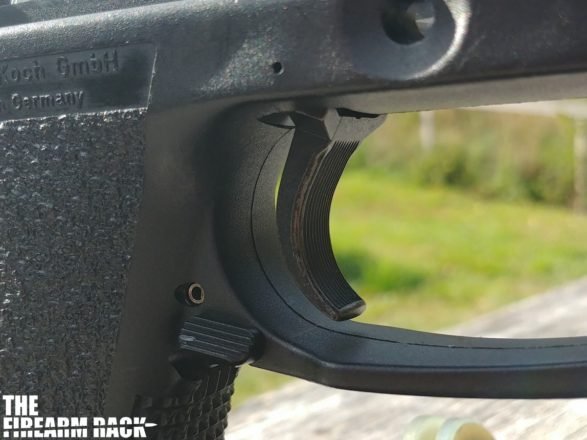
The Mark 23 features the beefiest slide rails that I have ever seen on a polymer frame handgun. These are solid steel rails that are set into the frame, rather than being molded into the polymer. The extra strength is needed for maintaining accuracy and reliability with the amount of reciprocating slide mass.
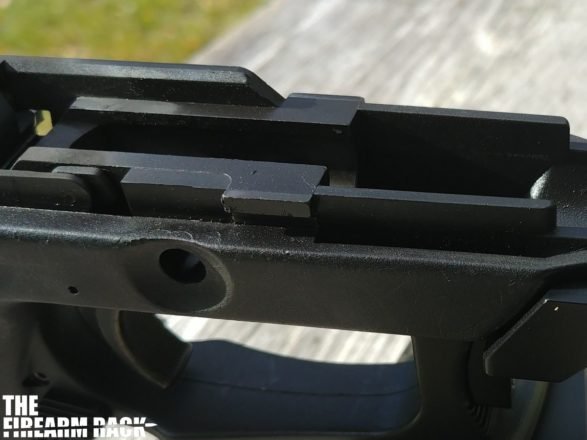
The fire control group of the Mark 23 is also fairly beefy, much akin to that of the USP.
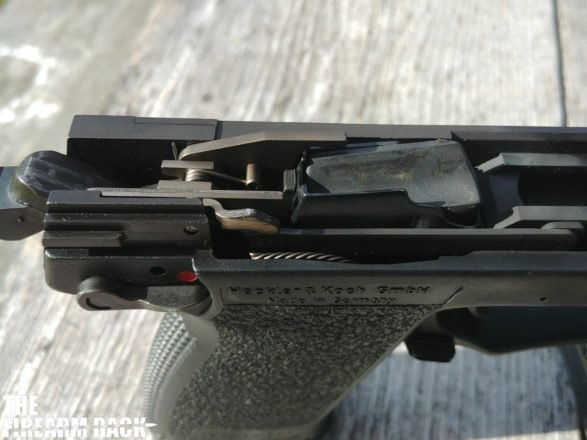
To eagle eyed readers, they probably saw that the Mark 23 hit the market in 96′, but know that the USP was released in 93′. So which one was made first?
Lineage of the Mark 23
It is true, the HK Universal Self-Loading Pistol (USP) hit the market three years before the Mark 23 did. However, without the Mark 23, the USP would not exist. The Mark 23 began development in 1990, and entered the OHWS testing in 1991. During this time, Heckler & Koch took the design, and scaled it down for more general use with regular military units, law enforcement, and the public commercial market. The .40 S&W USP was the first to hit the market, quickly followed by the 9x19mm variant. Two years later, in 1995, the USP45 was released.
The Mark 23 and the USP are very similar guns. To make an analogy, the USP is a guy who lifts weights 4 days a week and is buff, while the Mark 23 is chugging protein shakes, lifting 7 days a week, and doesn’t sleep. They both do similar things, but one does it a little (or a lot) harder.
The slide, frame, and magazine design of the USP are extremely similar to that of the Mark 23. The USP9 and .40 are less similar to the Mark 23 than the USP45, as the 9 & .40 use polymer magazines, while the 45 uses steel mags. The slides of the Mark 23 and the USP45 are very similar, with the same locations for roll pins in the rear, and even the same wear patterns on the hoods of the barrels.
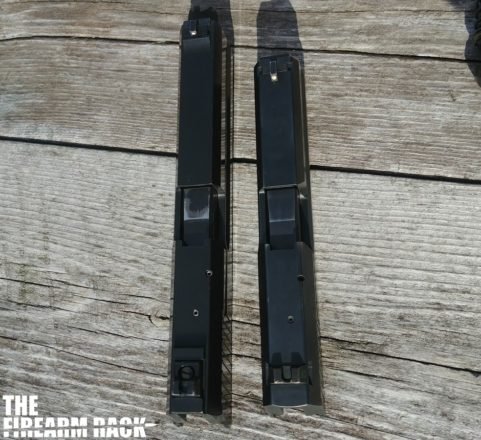
The undersides of the two pistols are also extremely similar. The Mark 23 has a beefier firing bin block and recoil assembly, but is otherwise the same. The Mark 23 is rated to fire .45 Super (an extremely overpressured .45ACP) out of the box, however the USP45 requires enhanced springs to do so safely.
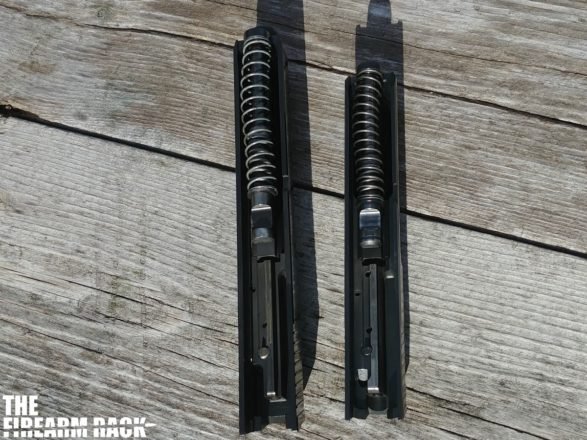
The texture on the frames of both pistols are the same, with the same grip angle and general feel. The controls on the USP are simplified, with many variants having a combined safety/decocker, rather than two separate levers like the Mark 23. This particular USP45 was the LEM variant, which features no safety or decocker.

The Mark 23 and the USP were two of the first handguns to feature an accessory rail for mounting lights and lasers. It was made before 1913 rails were developed, however the universal HK rail never really caught on. If you have a Mark 23 or USP, you’ll need an aftermarket adapter to mount modern lights.
Going forward with HK designs, every hammer fired gun has been an evolution on the Mark 23’s general design. The from the USP to the P30L, each gun down the line has a little hint of Mark 23 in it, in some form or fashion.
The Mark 23 in Media
Popular media sells guns. We know this. Die Hard brought the Beretta 92 to the silver screen, cementing it as a gun that people wanted, and the Mark 23 is no different. Heckler & Koch have always been able to rely on media to help do part of their marketing for them. The images of British SAS repelling into the Iranian Embassy in 1980, while wielding MP5s was big in selling guns, but so was the late 1990’s videogame boom.
Tom Clancy wrote many books, scripts for films, and was the cornerstone for many video game franchises. The first appearance of the Mark 23 (by name) in video games was in 1998’s Tom Clancy’s Rainbow Six. Rainbow Six also introduced the USP to video games, and created a long series of games, still spanning today. However, later in 1998, a bigger video game was released, one that married the Mark 23 to its protagonist.
At the end of the summer of 98′, Metal Gear Solid was released. The premise is (somewhat) simple; sneak into the Alaskan missile base Shadow Moses Island, find the DARPA Chief, and stop the terrorists. Things don’t go so smoothly, but our protagonist Solid Snake still makes it out at the end. The game received critical acclaim, and rightly so. However, a stunning aspect of the game was its attention to detail, specifically with the weapons. As a game centered around stealth, your toolkit needed to be suited for the job, and the first tool you find is the Mark 23. When found it already has the Laser Aiming Module equipped, and a sound suppressor can be found later on, making it a great weapon for many parts of the game.

I’d argue that Metal Gear Solid and it’s attention to weapon details has sold more Mark 23’s than any of HK’s own advertising. But that’s the beauty (or blunder) of Heckler & Koch’s marketing; the media and depictions of their guns sell more than what their marketing department can.
Shooting the Mark 23
The gun has the lineage and cool factor, but how does it shoot? The Mark 23 that I had the ability to shoot was a first year production gun, belonging to a close friend. We shot about 150 rounds of Blazer Brass 230gr hardball through the gun, during a group range trip. Bench rested shooting for groups was not done, as this was more about getting the “feel” of the Mark 23 in more practical applications.
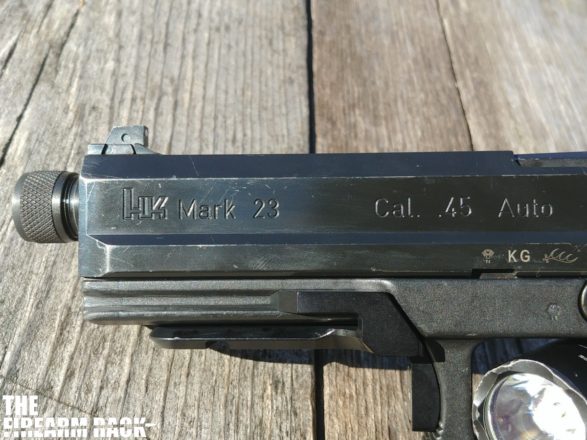
The double action trigger pull is heavy, but smooth. Very little creep is felt, and overtravel is minimal. The single action break is light, crisp, and allows for quick follow-up shots. The metal trigger is substantially better than the polymer triggers found in other HK handguns, a component that tends to lead to their creepy trigger pulls.
Recoil on the Mark 23 isn’t light, but it isn’t harsh. The slide is massive, slow the recoil impulse is slow, and has a “kachunk-kachunk” feel. I’m not the best shooter, but I’m pretty good, and with the Mark 23, I wasn’t able to be very fast. The amount of reciprocating slide mass makes it harder to keep your rate of fire up. It’s not unmanageable, but the time between shots is more than on a standard .45 handgun.
The 3-dot sights are plenty usable. The rear notch is tighter than I’d like, and the front post is too thick, but you can still get accurate hits easily enough.
The safety and decocker both click positively, making use fairly simple. The safety is much akin to the 1911, and the decocker is very similar to that of the SIG P22X line. The decocker sits rather flush to the frame, making it hard to accidentally hit, but also hard to intentionally use. The safety is great however, not too big, or too small.
Overall, shooting the Mark 23 was a blast (pun intended). Is it still a practical gun in the era of MRDS equipped handguns, and capacity being king? Well….
Heckler & Koch Mark 23: Conclusion
The needs of the 90’s are much different than what we want today. The Mark 23 is a cool gun, but I don’t believe it to practical anymore. It was made to be an impromptu primary weapon for operators in the 90’s, but compared to pistols with modern accessories of today, it is not going to cut it. It’s too big, holds too few rounds, can’t fit modern accessories well, and is too expensive to produce. However, this is no knock against the gun. It is a statement of its era, and led to much development in handgun design for years to come.
If you have the ability to shoot one, go for it. If you are a fan of Heckler & Koch, or of cool handguns, get yourself a Mark 23 while they still exist in the wild.
Big thanks to Nathan S. for allowing me to borrow his Mark 23 for the writing of this article.
Webpages sited for this article:
- https://en.wikipedia.org/wiki/Heckler_%26_Koch_Mark_23
- https://en.wikipedia.org/wiki/United_States_Special_Operations_Command
- https://en.wikipedia.org/wiki/Heckler_%26_Koch_USP


1 Trackback / Pingback